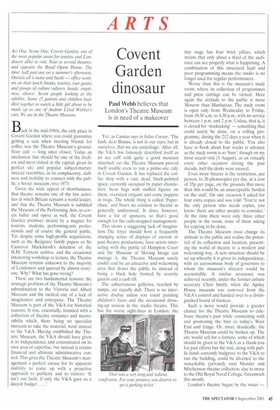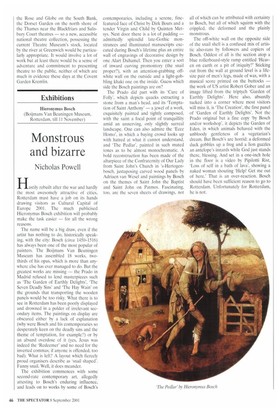Covent Garden dinosaur
Paul Webb believes that London's Theatre Museum is in need of a makeover
Act One, Scene One: Covent Garden, one of the most popular areas for tourists and Londoners alike to visit. Near to several theatres, and opposite the Royal Opera House. The time: half past one on a summer's afternoon. Outside ail is noise and bustle — office workers on their lunch breaks, tourists, tour guides and groups of culture vultures. Inside: emptiness, silence. Seven people looking at the exhibits. Some 15 parents and children huddled together to watch a little girl about to be made up as one of Andrew Lloyd Webber's cats. We are in the Theatre Museum.
Back in the mid-1980s, the only place in Covent Garden where you could guarantee getting a seat when meeting friends for coffee was the Theatre Museum's groundfloor café — long since closed. Today an institution that should he one of the liveliest and most visited in the capital, given its perfect site and popular subject-matter, instead resembles, in its complacency, dullness and inability to connect with the public, a Soviet museum circa 1973.
Given the wide appeal of showbusiness. that theatre remains one of the few activities in which Britain remains a world leader, and that the Theatre Museum is subtitled the Museum of the Performing Arts, so covers ballet and opera as well, the Covent Garden premises should be a magnet for tourists, students, performing-arts professionals and of course the general public. Yet despite some high-profile acquisitions, such as the Redgrave family papers or Sir Cameron Mackintosh's donation of the H.M. Tennent archive, and the occasional interesting workshop or lecture, the Theatre Museum remains unknown to the majority of Londoners and ignored by almost everyone. Why? What has gone wrong?
There are two fundamental reasons: the strategic problem of the Theatre Museum's subordination to the Victoria and Albert Museum and the tactical one of a lack of imagination and enterprise. The Theatre Museum is part of the V&A for historical reasons. It was, essentially, founded with a collection of theatre costumes and memorabilia which, there being no specialist museum to take the material, went instead to the V&A. Having established the Theatre Museum, the V&A should have given it its independence and concentrated on its own area of expertise, but instead it retains financial and ultimate administrative control. This gives the Theatre Museum's management a perfect excuse for its apparent inability to come up with a proactive approach to publicity and to visitors: 'It isn't our fault; if only the V&A gave us a decent budget .. ..'
Yet. as Cassius says in Julius Caesar, 'The fault. dear Brutus, is not in our stars, but in ourselves, that we are underlings.' After all. the V&A has famously described itself as an ace caff with quite a good museum attached; yet the Theatre Museum proved itself unable even to run a prime-site café in Covent Garden. It has replaced the coffee shop with a vast, dead, black-painted space, currently occupied by paper chandeliers, bean bags with stuffed figures on them, oversized origami and some puppets in twigs. The whole thing is called Taperchase' and bears no relation to theatre as generally understood. It does, however, have a list of sponsors, so that's good enough for the cash-strapped management.
This shows a staggering lack of imagination. The foyer should host a frequently changing series of displays of current or past theatre productions, have actors interacting with the public (if Hampton Court and the Museum of Moving Image can manage it, the Theatre Museum surely could) and be an attractive and welcoming area that draws the public in, instead of being a black hole fronted by security guards and a cash till.
The subterranean galleries, reached by ramps, are equally dull. There is no interactive display unless you count painting children's faces and the occasional dressing-up session in the studio theatre. This has the worse sight-lines in London: the tiny stage has four brick pillars, which means that only about a third of the audience can see properly what is happening. A combination of this structural fault and poor programming means the studio is no longer used for regular performances.
Worse than this is the museum's study room, where its collection of programmes and press cuttings can be viewed. Here again the attitude to the public is more Moscow than Manhattan. The study room is open only from Wednesday to Friday, from 10.30 a.m. to 4.30 p.m., with no service between 1 p.m. and 2 p.m. Unless, that is, it is closed for 'stocktaking' — something that could surely be done, on a rolling programme, during the 212 days a year when it is already closed to the public. You also have to book about four weeks in advance as the study room is so 'busy', though on my most recent visit (1 August), as on virtually every other occasion during the past decade, half the desks were unused.
Even more bizarre is the restriction, per person, to 20 photocopies per day, at a cost of 35p per page, on the grounds that more than this would be an unacceptable burden on the staff. On one occasion I asked for four extra copies and was told: 'You're not the only person who needs copies, you know; there are other people to consider.' At the time there were only three other people in the room, none of them asking for copying to be done.
The Theatre Museum must change its attitude to the public and realise the potential of its collection and location, presenting the world of theatre in a modern and welcoming way. A new structure should be set up whereby it is given its independence, with an autonomous body of governors to whom the museum's director would be accountable. A similar severance was achieved recently, under the former culture secretary Chris Smith, when the Apsley House museum was removed from the V&A's control and handed over to a distinguished board of trustees.
Such a move would provide a greater chance for the Theatre Museum to celebrate theatre's past while connecting with and promoting the best in today's West End and fringe. Or, more drastically, the Theatre Museum could be broken up. The site would sell for a fortune, some of which should be given to the V&A as a thank-you for past efforts but the rest, along with public funds currently budgeted to the V&A to run the building, could be diverted to the remarkable (privately run) Mander and Mitchenson theatre collection, due to move to the Old Royal Naval College, Greenwich this month.
London's theatre began by the water — the Rose and Globe on the South Bank, the Dorset Garden on the north shore of the Thames near the Blackfriars and Salisbury Court theatres — so a new, accessible national theatre collection, possessing the current Theatre Museum's stock, located by the river at Greenwich would be particularly appropriate. It would involve a lot of work but at least there would be a sense of adventure and commitment to presenting theatre to the public, neither of which are much in evidence these days at the Covent Garden Kremlin.



































































 Previous page
Previous page